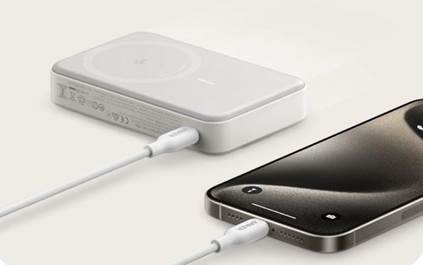Power
banks have become indispensable gadgets for our tech-driven lives. With an
ever-growing reliance on smartphones, tablets, and other portable devices,
having a reliable backup power source is crucial. Power banks offer the
convenience of charging devices on the go, ensuring you remain connected even
when electrical outlets are out of reach. This guide covers everything you need
to know about power banks, from their features and benefits to tips on choosing
the best one for your needs.

What is a Power Bank?
Definition and Basic Functionality
A
power bank is a portable electronic device designed to recharge gadgets like
smartphones, tablets, and other USB-powered devices. Essentially, it is a
battery surrounded by a durable casing, equipped with one or multiple USB ports
for charging various devices. By storing electrical energy, power banks provide
a convenient solution when access to a power outlet is unavailable, ensuring
your devices remain charged throughout the day.
Types of Power Banks and Their Uses
Several
types of power banks cater to different user needs: 1. Standard Power Banks:
Ideal for everyday use, these provide a balanced combination of capacity and
portability. 2. Solar Power Banks: Equipped with solar panels, these are
perfect for eco-conscious users and outdoor enthusiasts, offering renewable
energy sources. 3. Wireless Power Banks: Allow for cable-free charging of
devices that support wireless charging. 4. High-capacity Power Banks: Best
suited for heavy-duty users requiring multiple charges or extended power on the
go.
Key Features to Look for in a Power Bank
Battery Capacity: Understanding mAh Ratings
Battery
capacity, measured in milliampere-hours (mAh), determines how quickly a power
bank can charge your devices. Higher mAh ratings indicate more stored energy,
translating to more charges for your devices. For instance, a 10,000mAh power
bank can charge an average smartphone roughly three times. When choosing a
power bank, consider the battery capacity relative to your device’s battery
size.
Charging Speed: Input vs Output Power
Charging
speed is an essential feature impacting the efficiency of power banks. Input
power refers to how fast the power bank itself can be recharged, while output
power defines how quickly it can charge your devices. Look for power banks
supporting Quick Charge or other fast-charging technologies to ensure both
rapid replenishment of the power bank and swift charging of your gadgets.
Portability: Size and Weight Considerations
Portability
is crucial for those who are frequently on the go. Compact, lightweight power
banks are easy to carry, fitting comfortably into pockets or bags. Although
high-capacity power banks are typically bulkier, it’s essential to balance
capacity and portability. By considering both factors, you can choose a power
bank that aligns with your daily needs and lifestyle without compromising
convenience.
Benefits of Using a Power Bank
Convenience for Travel and Outdoors
Power
banks offer unmatched convenience, especially during travel or outdoor
activities. Whether exploring remote locations, flying cross-country, or
attending long events, having a dependable power source ensures your devices
stay functional. This is particularly useful for navigation apps, emergency
contacts, and capturing memories with your camera.
Emergency Charging: Essential for Unexpected
Situations
Unexpected
low battery situations can be highly stressful, especially when you're on the
go. A power bank serves as a reliable backup, giving you peace of mind during
emergencies. Whether you’re facing a power outage, traveling, or attending an
important meeting with a dying phone, a power bank ensures you stay connected
and productive without interruptions.
Multi-device Charging and Versatility
Modern
power banks are equipped with multiple ports, allowing users to charge several
devices simultaneously. This versatility is especially useful for individuals
with multiple gadgets, such as smartphones, tablets, and smartwatches.
Additionally, many power banks offer broad compatibility, supporting a wide
range of devices and enhancing their overall utility, making them an ideal
solution for on-the-go charging needs.

How to Choose the Best Power Bank for Your Needs
Matching Power Bank Capacity with Your Device
When
choosing a power bank, match its capacity to your device’s battery
requirements. Consider how often you use it and the types of devices you own.
Frequent travelers may opt for higher-capacity power banks to ensure they can
charge multiple devices on the go. Casual users, however, might prioritize
portability and ease of carrying for everyday use.
Considering Additional Features
Look
for power banks with features that suit your specific needs. Some models come
with built-in cables for convenience, solar panels for renewable energy, or
rugged designs ideal for outdoor adventures. Additional perks like LED
indicators, safety protections, and quick charge capabilities can also improve
usability and ensure efficient charging, making your power bank more versatile
and reliable.
Comparing Popular Brands
Researching
popular brands is key to understanding reliability and performance. Trusted
brands like Anker are known for their high-quality power banks, offering
durability and efficient charging. Be sure to compare specifications, read user
reviews, and check warranty options. This will help you make an informed
decision and choose a product that best fits your needs and expectations.
Conclusion
Power
banks are essential tools in a tech-savvy world, offering consistent and
reliable energy solutions for our gadgets. Understanding their features,
benefits, and selecting the right one can greatly enhance your device
management. Whether for travel, emergencies, or daily use, a power bank
ensures your devices remain charged and ready for action. Use this guide to
make a confident purchase and benefit from uninterrupted connectivity.
